Principles of Information Systems
Principles and Learning Objectives
Knowledge Management and Specialized Information Systems
Knowledge management allows organizations to share knowledge and experience among their managers and employees
Discuss the differences among data, information, and knowledge
Describe the role of the chief knowledge officer (CKO)
List some of the tools and techniques used in knowledge management
Artificial intelligence systems form a broad and diverse set of systems that can replicate human decision making for certain types of well-defined problems
Define the term artificial intelligence and state the objective of developing artificial intelligence systems
List the characteristics of intelligent behavior and compare the performance of natural and artificial intelligence systems for each of these characteristics
Artificial intelligence systems form a broad and diverse set of systems that can replicate human decision making for certain types of well-defined problems (continued)
Identify the major components of the artificial intelligence field and provide one example of each type of system
Expert systems can enable a novice to perform at the level of an expert but must be developed and maintained very carefully
List the characteristics and basic components of expert systems
Identify at least three factors to consider in evaluating the development of an expert system
Outline and briefly explain the steps for developing an expert system
Identify the benefits associated with the use of expert systems
Virtual reality systems can reshape the interface between people and information technology by offering new ways to communicate information, visualize processes, and express ideas creatively
Define the term virtual reality and provide three examples of virtual reality applications
Specialized systems can help organizations and individuals achieve their goals
Discuss examples of specialized systems for organizational and individual use

Why Learn About Specialized Information Systems?
Knowledge management (KM) and specialized information systems used in many industries
Examples
Manager might use KM to correct a problem
Automotive manager might use KM to oversee robots
Stock trader might use a neural network to uncover patterns in stock prices
Knowledge Management Systems
Data: raw facts
Information:collection of facts organized so that they have additional value beyond the value of the facts themselves
Knowledge:awareness and understanding of a set of information and the ways that information can be made useful to support a specific task or reach a decision
Knowledge management system (KMS):
Organized collection of people, procedures, software, databases, and devices
Used to create, store, share, and use the organization’s knowledge and experience
Data and Knowledge Management Workers and Communities of Practice
Data workers: data-entry personnel
- Secretaries, administrative assistants, bookkeepers, etc.
Knowledge workers:create, use, and disseminate knowledge
- Professionals in science, engineering, or business; writers; researchers; educators; corporate designers; etc.
Chief knowledge officer (CKO): top-level executive who helps the organization use a KMS to create, store, and use knowledge to achieve organizational goals
Communities of practice (COP): group of people dedicated to a common discipline or practice
- May be used to create, store, and share knowledge
Obtaining, Storing, Sharing, and Using Knowledge
Figure 11.3: Knowledge Management System
Creating or obtaining knowledge
- Knowledge workers often work in teams
Storing knowledge
- Knowledge repository: includes documents, reports, files, and databases
Sharing knowledge
- Collaborative work software and group support systems
- Nontechnical approaches
Using knowledge
- Begins with locating organization’s knowledge
Knowledge map or directory
Technology to Support Knowledge Management
An effective KMS is based on learning new knowledge and changing procedures and approaches as a result
- Organizational learning
- Organizational change
Data mining and business intelligence are important in capturing and using knowledge
Enterprise resource planning tools include knowledge management features
Groupware can help capture, store, and use knowledge
Hardware, software, databases, telecommunications, and the Internet are needed to support most knowledge management systems
Examples of knowledge management products and services
- IBM’s Lotus Notes and Domino
- Microsoft’s Digital Dashboard, Web Store Technology, and Access Workflow Designer
Table 11.1: Additional Knowledge Management Organizations and Resources
An Overview of Artificial Intelligence
Artificial intelligence (AI): ability of computers to mimic or duplicate functions of the human brain
Some AI applications
- Make medical diagnoses
- Explore for natural resources
- Determine what is wrong with mechanical devices
- Assist in designing and developing other computer systems
Artificial Intelligence in Perspective
Artificial intelligence systems: people, procedures, hardware, software, data, and knowledge needed to develop computer systems and machines that demonstrate characteristics of intelligence
Researchers, scientists, and experts on how human beings think are often involved in developing these systems
The Nature of Intelligence
Turing Test
- Determines whether responses from a computer with intelligent behavior are indistinguishable from those from a human being
Learn from experiences and apply knowledge acquired from experience
Handle complex situations
Solve problems when important information is missing
Determine what is important
React quickly and correctly to a new situation
Understand visual images
- Perceptive system: approximates how humans see, hear, and feel objects
Process and manipulate symbols
Be creative and imaginative
Use heuristics
The Difference between Natural and Artificial Intelligence
Table 11.2: A Comparison of Natural and Artificial Intelligence
The Major Branches of Artificial Intelligence
Figure 11.5: A Conceptual Model of Artificial Intelligence
Expert Systems
Hardware and software that stores knowledge and makes inferences, similar to a human expert
Used in many business applications
Robotics
Mechanical or computer devices that perform tasks:
Requiring a high degree of precision, or
Tedious or hazardous for humans
Robots are essential components of today’s automated manufacturing and military systems
Future robots will find wider applications in banks, restaurants, homes, doctor offices, and hazardous working environments
Vision Systems
Hardware and software that permit computers to capture, store, and manipulate visual images and pictures
Fingerprint analysis
Identifying people based on facial features
Used in conjunction with robots to give these machines “sight”
Natural Language Processing and Voice Recognition
Processing that allows the computer to understand and react to statements and commands made in a “natural” language, such as English
Voice recognition: converting sound waves into words
Learning Systems
Combination of software and hardware that allows the computer to change how it functions or reacts to situations based on feedback it receives
Learning systems software requires feedback on results of actions or decisions
Feedback is used to alter what the system will do in future
Neural Networks
Computer system that simulates functioning of a human brain
Capable of retrieving information even if some neural nodes fail
Quickly modifies stored data as a result of new information
Discovers relationships and trends in large databases
Solves complex problems for which all the information is not present
Figure 11.7: Neural Network Software
Other Artificial Intelligence Applications
Genetic algorithm: approach to solving large, complex problems in which a number of related operations or models change and evolve until the best one emerges
Intelligent agent: programs and a knowledge base used to perform a specific task for a person, a process, or another program
- Also called intelligent robot or bot



